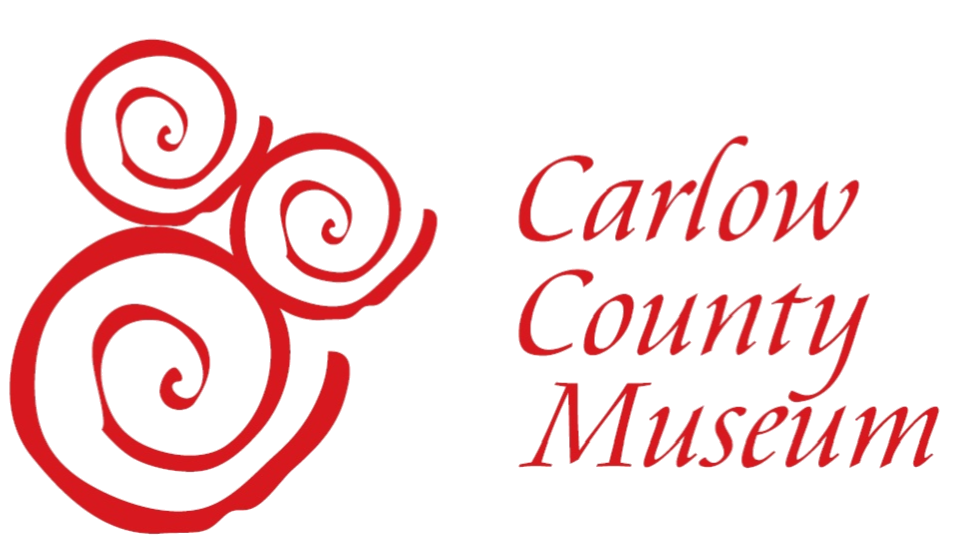About Us
ABOUT US
Carlow County Museum is operated by Carlow County Council in partnership with the Carlow Historical & Archaeological Society (CHAS). In April 2012 we opened at our present location on College Street, in the former Presentation Convent which was purchased by Carlow County Council in 1989. You enter the Museum through the Carlow Tourist Office, operated by Carlow Tourism on behalf of Fáilte Ireland and Carlow County Council.

Carlow County Museum’s Mission Statement is:
“Carlow County Museum is a not-for-profit institution that collects, safeguards, holds in trust, researches, develops and interprets collections of original objects and original objects on loan from County Carlow and its people for the public benefit where they can find inspiration.”
The mission of our parent body Carlow County Council, is that:
“our mission is to provide a quality local government service for the people of County Carlow, through the protection and enhancement of the environment and improvement of the quality of life. We will achieve this by fostering a partnership between the elected members and staff of Carlow Local Authorities and all sectors of the community. In a spirit of mutual trust, we will work in an open, effective and participative way, to ensure that County Carlow becomes an environmentally sustainable county, which is economically, culturally and socially inclusive and vibrant, where everybody can live and work in a healthy and safe community and where Carlow Local Authorities earn a reputation for the quality and efficiency of our services”.

Carlow County Museum is a Designated Museum by the National Museum of Ireland under the National Monuments Acts 1930 – 2004. Under this designation, Carlow County Museum is legally entitled to collect, retain, request and display archaeological objects on behalf of the State. Dermot Mulligan, Museum Curator, is the Designated Person for County Carlow.
Carlow County Museum is part of the Heritage Council’s Museums Standards Programme of Ireland (MSPI) which promotes professional standards in the care of collections in Irish museums and galleries. Carlow County Museum is the first museum in County Carlow to participate in the programme.
Carlow County Museum is a member of the Local Authority Museums’ Network (L.A.M.N) which represents the twelve Local Authority Museums across Ireland, which play a vital role in the social, cultural and economic life of regions across Ireland.

Carlow County Museum was founded and opened in December 1973 by CHAS, then called the Old Carlow Society, who are a registered Friendly Society, founded in 1946. Carlow County Museum was originally opened in a now demolished building in the grounds of the present-day Cathedral Parish Centre on College Street. In 1979 CHAS moved the museum to the former Theatre of the Town Hall, a space provided by Carlow Town Council. CHAS operated the museum on a voluntary basis with assistance from the Town Council along with government social and community employment schemes operated by the Society or through Eigse, the Carlow Arts Festival. In 2002, with the agreement of CHAS, Carlow Town Council took over the operations of the Museum in January 2002.

In 2000, the Town Council published Carlow 800, a master plan for the town, which identified the development of the Cultural Quarter, an area of the town to include: the County Library and Archive; Carlow County Museum and Tourist Office; the Cathedral of the Assumption; Carlow College/ St Patrick’s College; Visual Centre for Contemporary Art with the George Bernard Shaw Theatre. The Town Council continued to operate the Museum until June 2014 when all Town Council’s were abolished and the operations were taken on by Carlow County Council.

Acknowledging the important role of CHAS in developing and operating the museum for nearly thirty years and to continue their input into the Museum, the Board of Carlow County Museum Board was established in 2005. It consists of seven members, three Members of Carlow County Council, three representatives of CHAS and the Chief Executive’s nominee with the Museum Curator acting as secretary to the Board. The Board of Carlow County Museum is responsible for the preparation and approval of policies, strategies and mission statement to be implemented by the museum. All of these require the final approval of Carlow County Council. The Board does not have a direct role in the day-to-day management or operations of the Museum. The Chairpersonship of the Board rotates on an annual basis between the Council members and the CHAS Representatives.

The role of Carlow County Museum, like all county museums, is to collect, preserve, conserve, document and display the history of the County. County/ City Museums are significant in that they are a home for a county’s many historic treasures and maintain high standards of collection care. County/ City Museums are operated and funded by Local Authorities and are staffed by professional museum personnel..
Carlow County Museum’s logo is based on the archaeological Rock Art find at Dranagh, County Carlow found in November 2008. The meaning of these pieces of rock art are thus far lost in the mists of time, but they may have something to do with boundary markers, route ways, places of ancient significance and pilgrimage. They consist of cup marks surrounded by rings and lines linking them together. The Dranagh Rock Art is of granite, its original location is lost, but it was at some stage in recent centuries built facing inwards into a field boundary wall, but a change collapse of the wall revealed the secret the wall was containing. The piece was reported to the museum who in turn reported the find to the National Museum of Ireland and the National Monuments Service.









